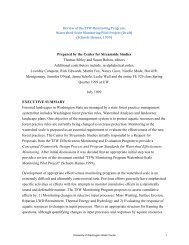Copyright 2012 Aileen M. Echiverri-Cohen - University of Washington
Copyright 2012 Aileen M. Echiverri-Cohen - University of Washington
Copyright 2012 Aileen M. Echiverri-Cohen - University of Washington
Create successful ePaper yourself
Turn your PDF publications into a flip-book with our unique Google optimized e-Paper software.
Miyake, 2004) and further construct validation work is needed to understand the specific types <strong>of</strong><br />
inhibitory processes deficient in PTSD.<br />
Taken together, inhibitory processes, particularly attentional ones, may play a critical role<br />
in the response to PTSD treatment. The present findings suggest that individuals who made<br />
more clinical improvements showed faster improvement in inhibition over the course <strong>of</strong><br />
exposure therapy, potentially highlighting the importance <strong>of</strong> irrelevant and relevant<br />
discrimination in attention in modifying the dysfunctional prefrontal-amygdala circuit in PTSD.<br />
Further, the interaction showed a large effect size and may be a mechanism <strong>of</strong> treatment<br />
response. The present study supports the utility <strong>of</strong> novel therapeutic interventions that target<br />
attention in PTSD. Although requiring replication with larger sample sizes, the findings from the<br />
current study also move the field forward in line with the new movement set by the Research<br />
Domain Criteria (RDoC) in developing a new research nosology that will refine our current<br />
diagnostic criteria by investigating more basic, bottom-up mechanisms (Sanislow et al., 2010). In<br />
conclusion, irrelevant and relevant discrimination in attention may be an important mechanism to<br />
recovery with PE treatment and may help advance our theories <strong>of</strong> therapeutic change in PTSD.<br />
49
















